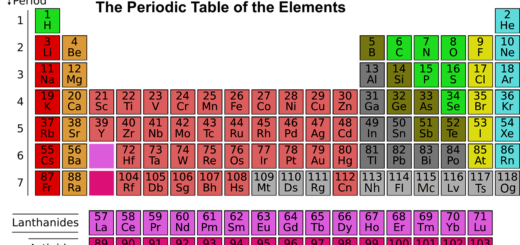Food: Where Does it Come From?
Summary of food where does it come from
Food
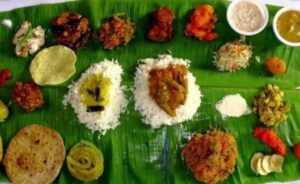
Summary
Food provides us energy which helps in growth and development.
Food Variety
Food variety represents one of the powerful ways to increase energy intake. There seems to be so much variety in the food that we eat.
Ingredients
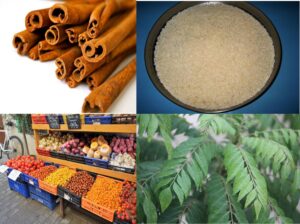
Any substances or materials that are required to produce a dish are called Ingredients.
Example:
-Atta (flour) and water are the two ingredients required to make a chapatti.
-Vegetable curry: we need different kinds of vegetables, salt, spices, oil, and so on.Boiled Rice: Raw rice and water, salt.
Food Materials and their sources
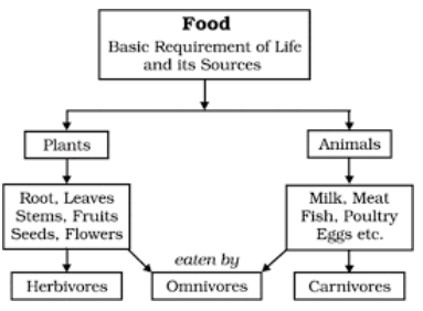
Plants act as sources of food ingredients such as fruits, vegetables, grains, pulses etc.
Animals are sources of food ingredients such as milk, eggs, meat products etc.
These are shown in the figure above.
Plants parts and Animals parts as food.
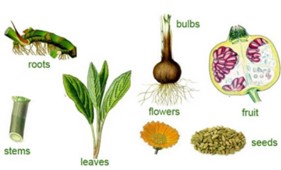
Some examples of edible plant parts are shown in the image above and their examples are given below:
- Roots: beets, carrots, radishes, turnips, ginger,
- Stems: broccoli stem, bamboo shoots, sugar cane, potato
- Leaves: spinach, lettuce etc.
- Fruits: apple, pear, tomatoes, grapes, cherries, oranges
- Edible Flowers: broccoli heads, cauliflower heads
What do the animals eat?

Animals can be classified into three broad categories in terms of what they eat as can be seen in the image above,
First we have the herbivores i.e. plant eaters. They only consume plant parts. Examples: Cows, goats, deer, giraffe etc.
Next we have the carnivores i.e. meat eaters. They only consume meat of other animals. Examples: Lions, tigers, vultures etc.
Last we have omnivores i.e. animals who eat both plant parts and meat products. Examples: Humans, bears etc.
There are five major components of food namely vitamins, minerals, proteins, carbohydrates and fats. While the diet of carnivores is rich in fats and proteins, there are some necessary vitamins and minerals in plant-based foods that their diet lacks. Similarly an all plant-based diet lacks in a good amount of protein and certain minerals.
It is important to know that there is difference between vegetarians and herbivores. While vegetarians make a conscious decision to not eat meat, herbivores on the other hand are incapable of eating meat and dairy products. Similarly carnivores lack the necessary enzymes in their stomachs to digest cellulose which is a major component of green food like grass.
Important Definitions
Nectar: The juicy sweet liquid secreted by within flowers which is sucked by bees and is made into honey by them
Sprouting: The process by which seeds shoot out small white structures as way of growth is called Sprouting.
Cellulose: It is a substance that is found in the cell walls of a number of plants. It is an indigestible fibre and is found in grass.
Enzymes: It is defined as a chemical substance that helps in bringing about changes to certain other substances without undergoing any changes in themselves.
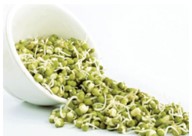
Exercise
1. Do you find that all living beings need the same kind of food?
Ans 1. No, all living beings do not need same kind of food.
Ans 2. No, All living beings do not need the same kind of food Some animals eat plants and there are called Herbivores animals some animals feed on other animals and they are carnivorous, some eat both plants and animals and there are called Omnivores.
2. Name the 5 plants and their parts that we eat.
Ans. The names of five plants and their parts that we eat are:
(i) Paddy: seeds
(ii) Wheat: seeds
(iii) Mustard plant: seeds and leaves
(iv) Brinjal plant: fruits
(v) Potato plant: stems
3. Match the items given in Column A with column B
| Column A | Column B |
| Milk, Curd, Paneer Ghee | Are all animal products |
| Spinach, Cauliflower, Carrot | Are vegetables |
| Lions and Tigers | Eat other animals |
| Herbivores | Eat plants and plants products |
Fill up the blanks with the words given
(herbivore, plant, milk, sugarcane, carnivore)
a) Tiger is a carnivore because it eats only meat.
(b) Deer eats only plant products and so, is called herbivore
(c) Parrot eats only plant products.
(d) The milk that we drink comes from cows, buffaloes, and
goats is an animal product.
(e) We get sugar from Sugarcane.
Extra Questions
Q. 1. Give two examples where two or more parts of a single plant are used as food.
Ans. Mustard — seeds and leaves,
Pumpkin — fruit and flowers.
Q.2. Name any one plant that grows in water and is eaten as food.
Ans. Lotus — Stem of lotus is eaten as food.
Q.3. Suggest any three ways you can think of to avoid wastage of food.
Ans. (i) Avoid leaving food uneaten in meals.
(ii) “Eat to live” and not “live to eat” — excess eating should be avoided.
(iii) Raw food like pulses, grains should be stored properly.
Q.4. Name two sugar producing plants.
Ans. (a) Sugarcane, (b) Sugarbeet.
Q.5. Name a non-green plant that we eat.
Ans. Mushroom.
Q.6. What do you call the habit of an individual to eat a particular type of food items commonly?
Ans. Food habit.
Q.7. Compare your food habits with food habits of your friend who lives in Tamil Nadu.
Ans. My food habit: Chapatti, pulses, lassi, rice, vegetables, mustard oil.
Food habit of my friend: Idli, dosa, sambhar, bara, rasam, upma and coconut oil, etc.
Q.8. What items are used to prepare cooked rice?
Ans. Raw rice and water.
Q.9. Study the ingredients of various food items. Do they have some common food ingredients?
Ans. Yes, they have some common ingredients like: water, salt and oil or ghee.
Q.10. What are the two common sources of most of the ingredients of food items?
Ans. (i) Plants (ii) Animals
Q.11. Name the three products each provided by plants and animals.
Ans. Plant products: Grains, cereals and vegetables.
Animal products: Milk, egg and meat.
Q.12. Name three edible (eatable) parts of plants.
Ans. (i) Roots, (ii) Fmits , (iii) Leaves
Q.13. Which part of the plants do we eat generally?
Ans. We generally eat fruits of many plants.
Q. 14. Which type of seeds give more energy, sprouted seeds or normal seeds?
Ans. Sprouted seeds give more energy than normal seeds.
Q.15. What is honey?
Ans. A sweet substance (liquid) prepared by bees from the riectar, i.e., sweet juice collected from flowers is called honey.
Q.16. Where would you place human beings on the basis of food that they eat?
Ans. Omnivores.
SHORT ANSWER TYPE QUESTIONS
Q.l. What is food?
Ans. The eatable substances eaten by humans and other animals to get energy for various activities for growth and development is called food.
Q.2. Why should we eat cooked food?
Ans. We should eat cooked food because by cooking we can kill harmful germs and make it germless. Cooked food can be easily digested and absorbed by our body. Cooking also improves the taste of food.
Q.3. Explain the importance of food for living organisms.
Ans. Importance of food is:
(i) It provides energy to do various activities.
(ii) It helps in growth.
(iii) It helps to repair and replace damaged parts of the body.
(iv) It protects us from infections and diseases.
Q.4. Explain the various sources of food items and ingredients with the help of examples.
Ans.
There are mainly two sources of ingredients of various food items:
(i) Plants: Plants provide us fruits, vegetables, pulses, grains, cereals, etc.
(ii) Animals: Animals provide us milk, eggs, meat etc.
Q.5. Define the term herbivores.
Ans. The animals which eat only plants or plant products are called herbivores. For example, cow, goat and buffalo.
Q.6. What are carnivores? Explain with examples.
Ans. The-animals which eat other animals are called carnivores. For example, lion and tiger. Carnivores generally eat herbivores and other carnivores.
Q.7. Define the term omnivores.
Ans. The animals which eat both the plants and animals are called omnivores. For example, cat, dog and human beings.
LONG ANSWER TYPE QUESTIONS
Q. 1. With the help of a flow chart show various contributors involved when we eat a chapatti.

Q.2. Make flow charts for the preparation of honey and ghee.
Ans. Preparation of honey:

Q. 3. Differentiate between herbivores, carnivores and omnivores. Give two examples of each

Q. 4. (i) Name the different parts of a banana plant that are used as food.
(ii) Animal food we get from water resources.
(iii) Four fruits which we eat as vegetables.
Ans. (i) Flower, fruit and stem of banana.
(ii) Fish, prawn, lobustar and crabes.
(iii) Fruits of tomato, brinjal, Ladyfinger (bhindi), cucumber (Loki).



